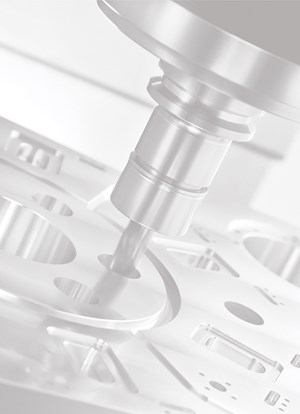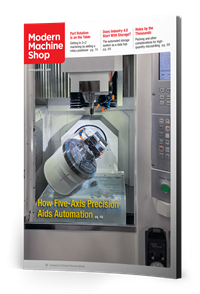Share






 Renishaw RMP60 probes in action on the Huron KXG 4523 during setup verification. Blum-Novotest probes are also part of Cavalier Tool & Manufacturing’s toolkit. Source | Cavalier Tool & Manufacturing
Renishaw RMP60 probes in action on the Huron KXG 4523 during setup verification. Blum-Novotest probes are also part of Cavalier Tool & Manufacturing’s toolkit. Source | Cavalier Tool & ManufacturingThe decision to eliminate CMM from the shop floor might seem risky, but it can drive significant improvements. “We eliminated the CMM to ensure everyone focuses on the process. Without it, there's no fallback — you have to get it right the first time,” says Brian Bendig, President and CEO of Cavalier Tool & Manufacturing.
Here are a few recommendations from Bendig for making the move to in-process quality:
1. Equipment Upgrades
Success begins with investing in better equipment. The transition requires upgrading from basic table clamps to FCS systems for enhanced clamping and fixturing, investing in machine tools that deliver higher accuracy and changing your toolholding by moving from twist lock with side bolts to shrink-fit holders that provide better balance and accuracy at high speeds.
“Combined with optimized programming and cooling strategies, these upgrades create a foundation for consistent quality,” Bendig says.
2. In-Process Verification
Modern machine tool probing capabilities now handle quality verification. “You'll machine a job with critical features, and before removing it from the machine, you use the probe. With the program already set up, you can verify the dimensions against the expected calculations,” Bendig says.
By comparing actual cuts against the CAD model, operators can catch and fix issues immediately. If a worn tool leaves excess stock on a critical feature, the program can be adjusted on the spot or modifications can be incorporated into downstream operations like EDM.
3. People and Change Management
The biggest challenge isn’t technical — it’s people. “People are always a challenge. People like habits,” Bendig says. New employees adapt quickly because they don't know the old way. Veterans with years of experience need more time to embrace the changes. Success depends on creating an environment where problems can be openly discussed and documented.
Cavalier Tool’s refined processes, driven by better equipment and real-time verification, deliver the quality its moldmaking customers demand.
4. Problem-Solving Systems
The shop implemented a “Things Gone Wrong” (TGW) system requiring issues to be photographed and reported through its ISO process. Problems get traced back to their source — whether in design, programming or machining.
As Bendig explains, “It’s one thing to know what you did wrong. It’s a second thing to know how to fix it, but it’s a third to never let it happen again.” This approach prevents repeat issues through better documentation and shared learning.
Today, the company rarely uses CMM services unless specifically requested by customers. Its refined processes, driven by better equipment and real-time verification, deliver the quality its moldmaking customers demand.
Related Content
-
4 Commonly Misapplied CNC Features
Misapplication of these important CNC features will result in wasted time, wasted or duplicated effort and/or wasted material.
-
6 Machine Shop Essentials to Stay Competitive
If you want to streamline production and be competitive in the industry, you will need far more than a standard three-axis CNC mill or two-axis CNC lathe and a few measuring tools.
-
Obscure CNC Features That Can Help (or Hurt) You
You cannot begin to take advantage of an available feature if you do not know it exists. Conversely, you will not know how to avoid CNC features that may be detrimental to your process.
















